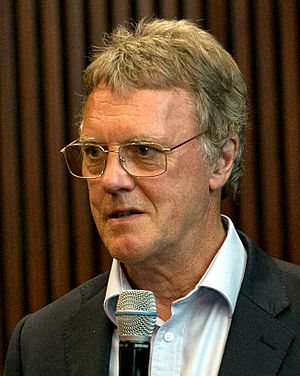Peter J. Ratcliffe facts for kids
Quick facts for kids
Peter J. Ratcliffe
FRS FMedSci
|
|
|---|---|

Ratcliffe in 2019
|
|
| Born |
Peter John Ratcliffe
14 May 1954 |
| Education | Gonville and Caius College, Cambridge St Bartholomew's Hospital Medical College |
| Awards | Fellow of the Royal Society Albert Lasker Award for Basic Medical Research Physiological Society Annual Review Prize Lecture Louis-Jeantet Prize for Medicine Knight Bachelor Fellow of the Academy of Medical Sciences EMBO Membership Baly Medal Grand Prix scientifique de la Fondation Lefoulon-Delalande Robert J. and Claire Pasarow Foundation Medical Research Award Nobel Prize in Physiology or Medicine |
| Scientific career | |
| Institutions | Francis Crick Institute Nuffield Department of Population Health, University of Oxford |
Sir Peter J. Ratcliffe is a famous British physician-scientist. He is known for his amazing discoveries about how our bodies' cells sense and react to oxygen levels. His work has helped us understand many important things about health and disease.
In 2019, Sir Peter shared the Nobel Prize in Physiology or Medicine. He received this top award with two other scientists, William Kaelin Jr. and Gregg L. Semenza. They were honored for their groundbreaking research on how cells adapt when there isn't enough oxygen.
Contents
Early Life and Education
Peter John Ratcliffe was born in Lancashire, England, on May 14, 1954. His father was a lawyer, and his mother worked as a telephonist.
He went to Lancaster Royal Grammar School from 1965 to 1972. After that, he earned a scholarship to study medicine at Gonville and Caius College, Cambridge, part of the University of Cambridge. He finished his medical degree in 1978 at St Bartholomew's Hospital Medical College.
Later, Ratcliffe trained in kidney medicine at University of Oxford. He focused on how oxygen affects the kidneys. He earned a higher medical degree from the University of Cambridge in 1987.
A Career in Science
In 1990, Sir Peter Ratcliffe received a special grant called a Wellcome Trust Senior Fellowship. This allowed him to study how cells respond to low oxygen levels, also known as hypoxia.
From 1992 to 2004, he was a senior research fellow at Jesus College, Oxford. In 2002, he became a member of the Academy of Medical Sciences. The next year, he was made a professor and head of a department at Oxford University.
From 2004 to 2016, he was a practicing doctor at the John Radcliffe Hospital in Oxford. He also led the Nuffield Department of Clinical Medicine at the University of Oxford. Since 2004, he has been a Fellow at Magdalen College, Oxford. In 2016, he became a Clinical Research Director at the Francis Crick Institute. He also kept a role at Oxford University.
Discovering How Cells Sense Oxygen
In 1989, Sir Peter started his own lab at University of Oxford. He wanted to understand how the kidneys produce a hormone called erythropoietin (EPO). EPO is important because it tells the body to make more red blood cells. The kidneys release EPO when there isn't enough oxygen. Sir Peter wanted to find out how the kidneys knew when oxygen levels were low.
His research showed that the ability to sense low oxygen wasn't just in the kidneys. It was also found in other organs like the spleen, brain, and testes. His team discovered that cells from these organs could also start making EPO when they didn't get enough oxygen. He even found a way to give other cells this oxygen-sensing ability.
Working with William Kaelin and Gregg Semenza, Sir Peter's group made a huge breakthrough. They figured out the exact steps cells use to sense oxygen. They found that certain proteins, called hypoxia-inducible factors (HIF), are key. When oxygen levels are normal, another protein (from the VHL gene) attaches to HIF. This attachment leads to HIF being destroyed.
But when oxygen levels drop, the VHL protein can't attach to HIF anymore. This allows HIF to stay active and turn on the EPO gene, making the body produce more red blood cells. This whole process happens very quickly, helping the body react fast to low oxygen.
This same pathway is also active in many cancer tumors. It helps tumors grow new blood vessels to get the oxygen and nutrients they need. Thanks to Sir Peter's work, we now understand much more about how cells react to low oxygen. This knowledge has led to new medicines that can help people with conditions like anaemia and kidney failure.
Awards and Recognition
Sir Peter Ratcliffe has received many important awards for his work on hypoxia.
- The Louis-Jeantet Prize for Medicine (2009)
- The Canada Gairdner International Award (2010)
- The Lasker Award, with William Kaelin and Gregg Semenza (2016)
- Buchanan Medal of the Royal Society (2017)
- Massry Prize (2018)
- Nobel Prize in Physiology or Medicine, with William Kaelin and Gregg Semenza (2019). The Nobel committee recognized them "for their discoveries of how cells sense and adapt to oxygen availability."
- Member of the German Academy of Sciences Leopoldina (2020)
He was also made a knight in 2014 for his services to medicine. This means he can use the title "Sir."
See also
 In Spanish: Peter Ratcliffe para niños
In Spanish: Peter Ratcliffe para niños


